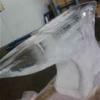-
Posts
648 -
Joined
-
Last visited
Content Type
Profiles
Forums
Articles
Gallery
Downloads
Events
Posts posted by Frozenforge
-
-
As said before a Trenton anvil labeled ACME, (custom order by Mr Wile E. Coyote), made 1911. Appears to be in good condition and at .25 per lb when the usual going rate is around $3 to $4 per lb or higher, depending on your location, you got one heck of a deal!
-
S/N actually looks like A165233 which would make it 1918. 370should be the weight. Appears to be in good shape. Get to hammering,
-
Appears to be a Vulcan. Appears to be in descent shape. Research a rebound test to see if it is structurally sound. Depending on price if you live in an anvil rich area you can probably find a better quality anvil. Here in Alaska it would probably sell pretty quick if reasonably priced as not many anvils pop up for sale.
Probably be able to find a much better anvil at $4/lb in New England.
-
A large roll of the mig tip size is the velocity of the propane as it is injected. While you could just change the pressure to inject the same amount of propane with a .035 vs .023 tip the larger tip will not induce as much air due to the lower velocity and it runs rich.
Addition of the mig tip helps create laminar flow which keeps the velocity more stable. Small burrs or even scratches left by a drill bit cause turbulence in the propane stream too early and reduce the overall airflow of the burner. This applies to all of the NA burner designs.
-
That is a cast anvil. Clean an area on the face and do a rebound test to see if it is cast iron or cast steel. Cast steel is much better than cast iron or what we call an ASO. It is very common for cheaper cast anvils to have what appears to be a face plate in the casting.
-
You have changed too many specifics of the design to expect satisfactory results.
i suspect the butane canister is themain culprit. Even at 0 degrees thepropane will perform better than a butane canister.
-
Last time I looked at having a radiator repaired a replacement was cheaper than the repair quote.
-
The rosebud tips will melt.
A naturally aspirated or blown propane burner would be way less complicated and the NA burner requires no power. You would probably only need 1 3/4 inch burner for a properly insulated freon tank forge.
-
Hopefully you already have paid for it and are planning a stand for it!
-
On my Dewalt the 1-2-3 slide controls the gear reduction ratio with 1 being the slowest chuck rpm with the trigger fully depressed. The manual says to only change the speed setting when the drill is off and it has a mechanical feel to it when you change speeds so I assume it is a planetary transmission.
The clutch setting is separate and it also changes depending upon the speed you select. For example a clutch setting of 10 is very tight on speed 1 and gets looser as you select higher speed
-
Have never seen a Columbian with the triangle on both sides. Usually the letter associated with the weight is just on its own opposite the logo. If you get it please post some pictures!
-
Made in Columbus Ohio 1919. I dont see any areas where repairs were done. It has some chipped edges but is very usable as is!
-
The only part of the burner that gets to high temps is the flare providing it is running properly AND when you shut off the forge you either remove the burner or block it off so it doesn’t act like a chimney for all the heat in the forge.
The flare will slowly degrade over time.
-
I have to get to know someone for a while or have a good friend vouch for them before I give any really good deals or offer up free labor. A little cynical after giving a really good deal to someone only to see them double their money a few days later!
-
Should be 1911. We like pictures
-
Sometime between 1901 and 1912.
-
Appears to say 147 on the one side of the base which should be the weight. The other number 203515 is the S/N which indicate it was made around 1941 - 1943
-
1923 according to AIA. Mr Postman did mention the failure at the waist happened tomore Trenton avils than other brands.
-
Anvils in general? Millions. The anvil in varoius shapes and materials has been around since the copper age (4500BC to 3500BC)!
-
Should be from 1909.
-
Hay Budden, made in 1908, cant make out the weight.
-
The unobtainium brand!
-
Peter Wright, made sometime after 1910. Should be approx 150 lbs
-
The soft bricks crack very easily just from the thermal cycling. Hopefully you made it easy to replace the bricks! A thermally reflective coating applied to the inside will help. The only one that immediatly comes to mind is ITC-100. I know there are cheaper options but I cant think of their name


Burners 101
in Gas Forges
Posted
It might be pulling exhaust air from the forge into the burner. Try shielding the intakes of the burners to ensure they only get fresh air.